Related Research Articles

Vuosaari is a neighbourhood in the City of Helsinki, Finland. It is located by the sea in East Helsinki and with its area of 15.38 km2 (5.94 sq mi) is geographically the largest district in the city. It also has two Helsinki Metro stations, Rastila and Vuosaari

Kiasma is a contemporary art museum located on Mannerheimintie in Helsinki, Finland. Its name kiasma, Finnish for chiasma, alludes to the basic conceptual idea of its architect, Steven Holl. Kiasma is part of the Finnish National Gallery, and it is responsible for the gallery's contemporary art collection. Its central goal is to showcase contemporary art and to strengthen its status.

Hakaniemi is an unofficial district of Helsinki, the Finnish capital. It covers most of the neighbourhood of Siltasaari in the district of Kallio. Hakaniemi is located at the sea shore and is separated from the city centre by the Siltavuorensalmi strait and from the district of Linjat by the street Hämeentie. Historically, Hakaniemi was often associated with the working class and workers' associations. However, the cost of living has risen considerably in recent years and is now on par with that of the rest of central Helsinki.

Alko Inc is the national alcoholic beverage retailing monopoly in Finland. It is the only store in the country which retails beer over 5.5% ABV, wine and spirits. Alcoholic beverages are also sold in licensed restaurants and bars but only for consumption on the premises.

Arabianranta, sometimes simply Arabia, is a residential part of Helsinki, Finland. It is bound by Vanhankaupunginlahti bay from east, and connects to neighboring boroughs of Vanhakaupunki in north, Hermanni in south and Toukola and Kumpula in west. It is part of the greater Toukola region.

Lauttasaari is an island in Helsinki, Finland, about 3 kilometres (1.9 mi) west of the city centre. Together with some surrounding unpopulated small islands, Lauttasaari is also a district of Helsinki. With 23,226 residents as of 2017, the island is Finland's second largest by population, after Fasta Åland. Its land area is 3.85 km2.

The Senate Square presents Carl Ludvig Engel's architecture as a unique allegory of political, religious, scientific and commercial powers in the centre of Helsinki, Finland.
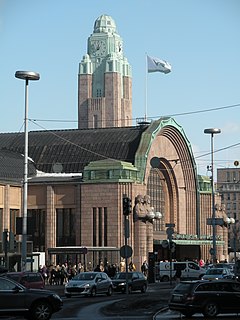
Helsinki Central Station (HEC) is the main station for commuter rail and long-distance trains departing from Helsinki, Finland. The station is used by approximately 400,000 people per day, of whom about 200,000 are passengers. It serves as the terminus for all trains in the Helsinki commuter rail network, as well as for all Helsinki-bound long-distance trains in Finland. The Rautatientori metro station is located in the same building. All trains from Finland to Saint Petersburg and Moscow in Russia also depart from Helsinki Central Station.

Länsiväylä is a motorway in the Greater Helsinki area of Finland, mainly at the Helsinki conurbation. It is part of the Finnish national road 51. The road begins in Ruoholahti in western Helsinki and continues west through the island of Lauttasaari and then across the city border to Espoo. The Länsiväylä road continues all the way throughout the southern part of Espoo. It continues as a motorway until finally crossing the border west to Kirkkonummi.

Jätkäsaari is a peninsula and a quarter in Helsinki, the capital city of Finland. It is part to the Kampinmalmi district and Länsisatama neighbourhood. It was the location of the main container harbour in Helsinki until late 2008, when the harbour moved to the new facilities in Vuosaari. The terminal for passenger ferries to Tallinn, Estonia, remains in Länsisatama.
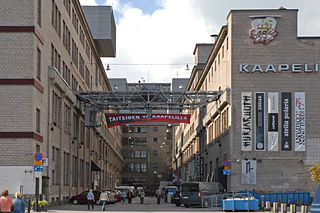
The Hotel and Restaurant Museum specializes in the history of Finnish hotels, restaurants, cafés, tourism and culinary culture. The museum is located in Kaapelitehdas, Helsinki, Finland. The museum was first opened in 1971 but has operated in its present premises since 1993. The museums collection includes about 20,000 artifacts and other objects from restaurants, bars, diners, spas and hotels. Museum's archives include about 38,000 photographs, menus and other documents. Museum also takes care of the Alko store museum's collection.
Martti Saario was a Finnish organizational theorist and Professor of Accounting at the Helsinki School of Economics, known for his development of the Finnish expenditure-revenue theory.
Martti Aiha is a sculptor from Finland. He was born in Pudasjärvi and worked in Fiskars.
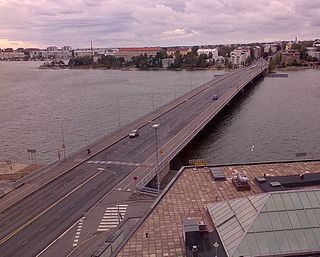
The Lauttasaari bridge is a bridge in Helsinki, Finland, over the Lauttasaarensalmi strait. The bridge connects the island of Lauttasaari to mainland Helsinki. The mainland end is in Salmisaari in the Ruoholahti district, with the Porkkalankatu street leading to the city centre. In Lauttasaari, the street Lauttasaarentie leads west from the bridge.

The Lauttasaari water tower was a water tower in Lauttasaari, Helsinki, Finland from 1958 to 2015. Its volume was 4400 cubic metres, its height was 34 metres and the diameter of the upper water container was 42 metres. The water tower was decommisioned in 1996 and dismantled from October to November 2015.
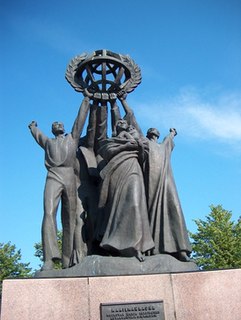
World peace is a bronze sculpture donated by the city of Moscow, Russia to the city of Helsinki, Finland, created by sculptor Oleg Kiryuhin. The sculpture was located at Hakaniemenranta in Helsinki, and it was revealed on 14 January 1990, two months after the Berlin Wall had been broken. The sculpture belongs to the collection of the Helsinki Art Museum. The sculpture was moved to storage on 8 August 2022.

Sompasaari is an island on the Kruunuvuorenselkä water area in the Sörnäinen district in Helsinki, Finland. On the southern side of the Nihdinkanava channel built in the middle of Sompasaari is the former island of Nihti.
The J. K. Paasikivi memorial, also called Itä ja Länsi is a memorial sculpture for President of Finland Juho Kusti Paasikivi by sculptor Harry Kivijärvi, located in Kamppi, Helsinki, Finland. The sculpture is located at the Paasikivenaukio square along Mannerheimintie in front of the so-called Supplier House, north of the Lasipalatsi building. The sculpture was revealed in 1980.

The Paavo nurmi statue is a whole-body sculpture of runner Paavo Nurmi, the most successful Olympic athlete in Finland, made by sculptor Wäinö Aaltonen. The bronze sculpture was made in 1925 and there have been four additional casts of it. The statue has become a symbol for Finnish sport and the independent Finnish nation as well as an envoy of the image of Finland.
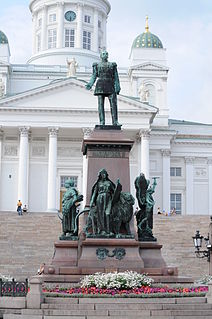
Alexander II is a monumental statue located at the Senate Square in central Helsinki, Finland.
References
- 1 2 Rumba, Helsinki Art Museum. Accessed on 20 September 2020.
- ↑ Rumba ja talo, Museum of Environmental Art. Accessed on 20 September 2020.
- ↑ Valorinta, Riitta: Martti Aiha, Art Association of Finland 19 August 2008. Accessed on 20 September 2020.
- ↑ Vehkasalo, Jussi: Samassa paikassa liki 30 vuotta nököttänyt vinkeä veistos puretaan ja viedään varastoon Helsingissä, Helsingin Uutiset 19 August 2020. Accessed on 20 September 2020.
Coordinates: 60°9′47.52″N24°54′17.64″E / 60.1632000°N 24.9049000°E